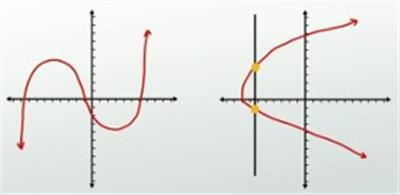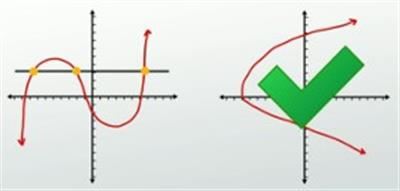Finding Inverses
So, now that we know what inverse functions are, how might you go about finding one? Say we have the function g(x) = sqrt(2x - 3) shown here, what would the inverse of g be?

If a vertical line crosses the graph in more than one place, the relation is not a function
Well, okay, since g(x) is really just a different way of saying y, we could rewrite our function like this: y = sqrt(2x - 3). Now, relying on the knowledge that the inverse is a list of steps that are the exact opposite as the original, we can use the following trick to find any inverse function. Switching the x and the y and now solving the equation for y with inverse operations will provide us with the exact set of steps that will undo the original function.
Doing that here would mean we'd first square both sides to undo the square root, then add 3 to both sides to undo the subtraction, and finally divide by 2 to undo the multiplication. The equation we end up with, (y = (x 2 + 3) / 2), is the inverse because it includes all of the inverse operations in reverse order of the original function. Therefore, g-1(x) = (x2 + 3) / 2.
The Horizontal Line Test
The last thing to cover has to do with specifics regarding what makes a function and therefore what makes its inverse. You'll need to remember that any function can only have one output for each input. One common way to test this is called the vertical line test. By tracing a vertical line across the graph, we can check to see if the relation is indeed a function. If our imaginary vertical line crosses the graph in more than one place, the relation is not a function, but if it passes across the entire graph and only ever touches the graph in one spot, it is.

We can use a similar tactic to also test whether the inverse is a function as well, but now, similar to how we switch the x and the y to find the inverse, we switch the vertical line to a horizontal line. This means that in order to test whether a relation's inverse is a function, we use the horizontal line test instead of the vertical line test, but everything else is the same. We trace this imaginary horizontal line across the graph, looking for a place where it touches more than once. If it never does, the inverse is a function, but if it ever touches the graph in more than one spot, the inverse is not a function.
Lesson Summary
There's a lot to know about inverse functions, so let's review what we've learned. A function's inverse is another function that does the exact opposite, and we use the negative one power to express it: f -1(x).
If we compose a function with its inverse, the two functions essentially undo each other, leaving us right back where we started - the x. We can figure out what the inverse of a function is by swapping the x and the y and then re-solving the equation for y. And finally, to test whether or not the inverse is a true mathematical function, we can use the horizontal line test to see if our imaginary horizontal line ever touches the graph in more than one spot.
Learning Outcomes
After viewing this lesson you should be able to formulate a function's inverse and use the horizontal line test if an inverse function is a true function.